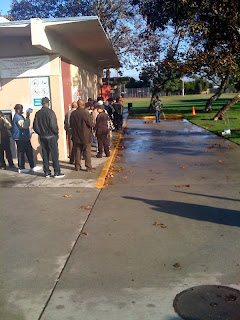In the 21 months since
Senator Barrack Obama has been campaigning to become the next US President,much has been said about his campaigns web prowess. In the beginning his campaigns seamless combination of grassroots methods and internet tools got a lot of comparisons to current DNC Chairman Howard Dean, who ran for US President in 2004.
But I think that one of the things that has changed since then is the fluid merger that occurs on a daily basis between web 2.0 tools and the ordinary daily communication rituals of so many Americans and folks around the globe. I mean, it used to be that if you witnessed a newsworthy event, the next thing you did was get on the phone to try to contact someone from the local media to see if they were interested in doing a story. From there you went to your friends to drum up some buzz with them, as they passed the story around. And if you were really lucky the reporter that you contacted would have gotten back to you to do a story and after the story was run it promptly dropped off of the radar. But more than likely the final stop for your story was your friends. Do you remember those days? It was not so long ago and in fact, in 2004 when Howard Dean ran for President things were just beginning to shift from this old paradigm.
But today the ordinary passer by has more access to worldwide communication channels than ever before through tools like: Twitter, Facebook, Youtube, Shozu, Now Public, and the list just keeps growing by the day. If you happen to capture on your cell phone either a photo, a video, or even just a short eyewiteness account of a newsworthy event and use any of the Web 2.0 channels that I just mentioned your message can instantly be seen or heard by millions within a few minutes or hours. This is what not only Senator Obama has been tapping into, but even the voters ourselves are doing it too.
So this piece is actually about an email that I received today that pointed to an article written by
Simon Owens referencing several Web 2.0 citizens media/social media tools that are already in heavy use in this election-as we speak. In Simon's PBS Media Shift article entitled, "
Citizens, Media Use Social Media to Monitor Election" he mentions several tools that you can use from the field to let the world know (in realtime) about your experiences at the polls. Here are the one's that Simon mentions:
Additionally, Simon also spoke with the creator of the
Voter Suppression Wiki-Mr. Baratunde Thurston who is also Co-Founder of
Jack and Jill Politics. Here is an excerpt that goes into more detail:
"Though many of these tools will be utilized in locating instances of election problems, Voter Suppression Wiki was created almost exclusively for that purpose. Baratunde Thurston, co-founder of the blog Jack and Jill Politics, came up with the idea after brainstorming with a number of bloggers and activists. (Another wiki, Election Protection, employs similar tools). Using the Wetpaint platform, Thurston hopes to tackle voter suppression in three parts.
"One is to define what voter suppression is," he said. "Whether it's false information, voter ID intimidation, allegations of fraud. And then we want to start tracking and reporting incidents of voter suppression; we have this form we put up where you enter where this happened, how many voters were affected, in what county did it occur. But most importantly was action. How to actually prevent or limit the amount of suppression."
Most of the battle in fighting voter suppression, Thurston argued, is empowering the voter before he or she heads to the polls. To that effect he's using the website to help promote a number of election protection phone numbers and resources. Thurston said that he hopes that the wiki can be used in real time; analyzing the data after the election can be useful in record keeping, but without quick and efficient action it will do little to protect the integrity of the election.
I asked Thurston about the nature of these election tools and whether they represent a new step in the utilization of online media in politics. In an election year when Barack Obama has been labeled by some to potentially be the "first Internet president" (much in the same way that FDR was the first radio president, and JFK was the first television president), have citizens created a new level of interactive politics?
"The long answer is that this effort, this project -- the Twitter project, the video project, and more -- are a kind of a next step in the evolution of online political participation," he replied. "Initially what you'd see on the web is a lot of opinion. 'I have a thought, I have an idea.' 'I disagree strongly with this policy.' Then you saw Howard Dean tap into donations, and now with Obama tapping into that as well -- the concept of the web as being a kind of ATM machine. But what we see now is collaboration and constructive confrontation."
I hope that you find this information useful. Oh...I just got some more info from Simon, here is another really handy election tool-
http://www.anorangeamerica.com/-It aggregates tweets like Twitter Vote Report, but it creates a more abstract visualization of the aggregate conversation on Twitter showing frequency and context of election-related words.
Otherwise, my message to you is simple-
please get out and vote or help someone to do it. And please also remember that if you see something fishy today, while out voting-do not just be silent about it. Please use one of the tools in this article to let people know about it. Thank you!




